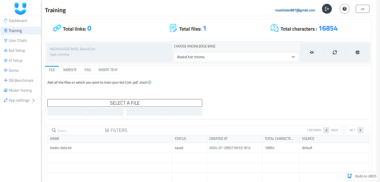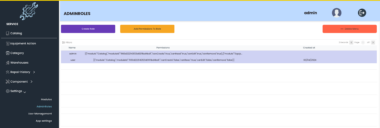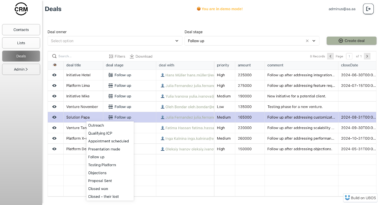MCP Memory Server with Qdrant Persistence
This MCP server provides a knowledge graph implementation with semantic search capabilities powered by Qdrant vector database.
Features
- Graph-based knowledge representation with entities and relations
- File-based persistence (memory.json)
- Semantic search using Qdrant vector database
- OpenAI embeddings for semantic similarity
- HTTPS support with reverse proxy compatibility
- Docker support for easy deployment
Environment Variables
The following environment variables are required:
# OpenAI API key for generating embeddings
OPENAI_API_KEY=your-openai-api-key
# Qdrant server URL (supports both HTTP and HTTPS)
QDRANT_URL=https://your-qdrant-server
# Qdrant API key (if authentication is enabled)
QDRANT_API_KEY=your-qdrant-api-key
# Name of the Qdrant collection to use
QDRANT_COLLECTION_NAME=your-collection-name
Setup
Local Setup
- Install dependencies:
npm install
- Build the server:
npm run build
Docker Setup
- Build the Docker image:
docker build -t mcp-qdrant-memory .
- Run the Docker container with required environment variables:
docker run -d
-e OPENAI_API_KEY=your-openai-api-key
-e QDRANT_URL=http://your-qdrant-server:6333
-e QDRANT_COLLECTION_NAME=your-collection-name
-e QDRANT_API_KEY=your-qdrant-api-key
--name mcp-qdrant-memory
mcp-qdrant-memory
Add to MCP settings:
{
"mcpServers": {
"memory": {
"command": "/bin/zsh",
"args": ["-c", "cd /path/to/server && node dist/index.js"],
"env": {
"OPENAI_API_KEY": "your-openai-api-key",
"QDRANT_API_KEY": "your-qdrant-api-key",
"QDRANT_URL": "http://your-qdrant-server:6333",
"QDRANT_COLLECTION_NAME": "your-collection-name"
},
"alwaysAllow": [
"create_entities",
"create_relations",
"add_observations",
"delete_entities",
"delete_observations",
"delete_relations",
"read_graph",
"search_similar"
]
}
}
}
Tools
Entity Management
create_entities: Create multiple new entitiescreate_relations: Create relations between entitiesadd_observations: Add observations to entitiesdelete_entities: Delete entities and their relationsdelete_observations: Delete specific observationsdelete_relations: Delete specific relationsread_graph: Get the full knowledge graph
Semantic Search
search_similar: Search for semantically similar entities and relationsinterface SearchParams { query: string; // Search query text limit?: number; // Max results (default: 10) }
Implementation Details
The server maintains two forms of persistence:
File-based (memory.json):
- Complete knowledge graph structure
- Fast access to full graph
- Used for graph operations
Qdrant Vector DB:
- Semantic embeddings of entities and relations
- Enables similarity search
- Automatically synchronized with file storage
Synchronization
When entities or relations are modified:
- Changes are written to memory.json
- Embeddings are generated using OpenAI
- Vectors are stored in Qdrant
- Both storage systems remain consistent
Search Process
When searching:
- Query text is converted to embedding
- Qdrant performs similarity search
- Results include both entities and relations
- Results are ranked by semantic similarity
Example Usage
// Create entities
await client.callTool("create_entities", {
entities: [{
name: "Project",
entityType: "Task",
observations: ["A new development project"]
}]
});
// Search similar concepts
const results = await client.callTool("search_similar", {
query: "development tasks",
limit: 5
});
HTTPS and Reverse Proxy Configuration
The server supports connecting to Qdrant through HTTPS and reverse proxies. This is particularly useful when:
- Running Qdrant behind a reverse proxy like Nginx or Apache
- Using self-signed certificates
- Requiring custom SSL/TLS configurations
Setting up with a Reverse Proxy
- Configure your reverse proxy (example using Nginx):
server {
listen 443 ssl;
server_name qdrant.yourdomain.com;
ssl_certificate /path/to/cert.pem;
ssl_certificate_key /path/to/key.pem;
location / {
proxy_pass http://localhost:6333;
proxy_set_header Host $host;
proxy_set_header X-Real-IP $remote_addr;
}
}
- Update your environment variables:
QDRANT_URL=https://qdrant.yourdomain.com
Security Considerations
The server implements robust HTTPS handling with:
- Custom SSL/TLS configuration
- Proper certificate verification options
- Connection pooling and keepalive
- Automatic retry with exponential backoff
- Configurable timeouts
Troubleshooting HTTPS Connections
If you experience connection issues:
- Verify your certificates:
openssl s_client -connect qdrant.yourdomain.com:443
- Test direct connectivity:
curl -v https://qdrant.yourdomain.com/collections
- Check for any proxy settings:
env | grep -i proxy
Contributing
- Fork the repository
- Create a feature branch
- Make your changes
- Submit a pull request
License
MIT
Memory Server with Qdrant Persistence
Project Details
- delorenj/mcp-qdrant-memory
- @delorenj/mcp-qdrant-memory
- Last Updated: 4/2/2025
Recomended MCP Servers

一个用来实现简单页面倒计时的轻量级工具
Examples and tutorials for building AI applications with watsonx.ai Flows Engine
Model Context Protocol (MCP) Server for Graphlit Platform

This is the most comprehensive wordpress mcp server. Includes functionality to perform CRUD operations on Users, Blogs, Categories...

Heroku Platform MCP Server

MCP server to download entire websites



Connect a bitcoin lightning wallet to your LLM using Nostr Wallet Connect and Model Context Protocol
A Python-based MCP for use in exposing Notion functionality to LLMs (Claude)

Integrate librosa, whisper with LLMs to analyze music audio.
 From vibe coding to vibe deployment. UBOS MCP turns ideas into infra with one message.
From vibe coding to vibe deployment. UBOS MCP turns ideas into infra with one message.







